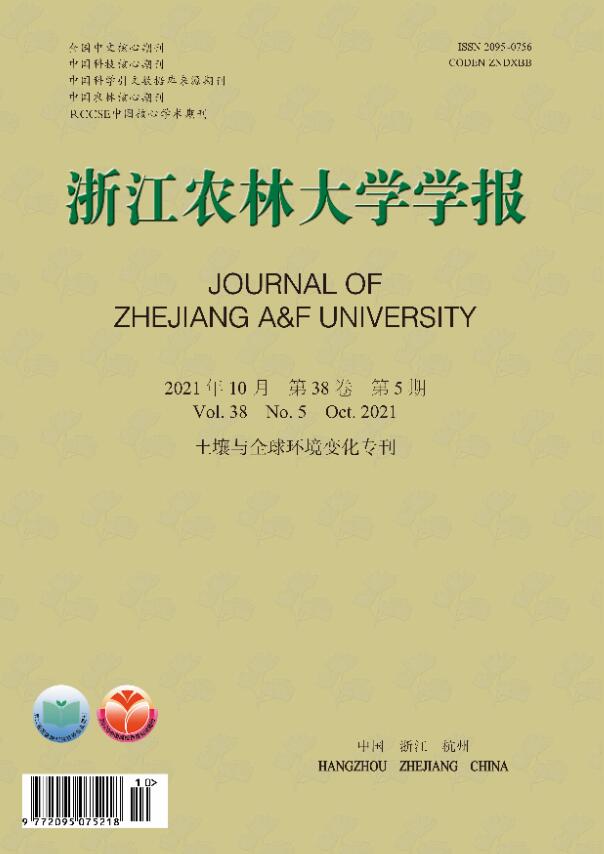-
全球土壤碳储量约为1 500 Pg,超过全球陆地植被碳储量和大气碳储量之和[1]。土壤呼吸年均释放80~95 Pg二氧化碳-碳(CO2-C)到大气中[2-3],是化石燃料燃烧产生二氧化碳排放量的11倍以上[4-5],是陆地生态系统第二大碳通量。全球范围内,森林在减缓气候变化方面发挥着重要的作用[6]。作为地下生态过程的土壤呼吸显著影响着陆地生态系统的碳循环[7],其通量过程已成为全球变化生态学研究的核心和焦点之一。一方面,大气中CO2等温室气体的增加是导致全球气候变化的主要原因。另外一方面,全球气候变化也会加速土壤呼吸速率,进一步增加CO2年排放量。CO2排放与全球气候变化的正反馈作用将放大全球气候变化对陆地生态系统的影响,因此备受学术界和各国政府关注[5, 8]。森林是陆地生态系统中最大的碳库,其面积约占陆地面积的1/3,对全球碳收支有着重要影响。森林土壤碳储量约占森林生态系统碳储量的2/3,约占全球土壤碳储量的39%[9-10]。森林土壤不仅是植被生长的基础,也是CO2的源、汇地之一,通过土壤呼吸排放到大气中的CO2是大气的重要碳源[11]。在碳中和背景下,被关注的重点是非自然变动引起的森林土壤呼吸的增加或减少,这种变化量才是森林生态系统的有效碳源或碳汇。森林生态系统中的人为干扰(如森林经营活动)能在很大程度上影响土壤CO2排放[12]。其中,森林采伐作为最重要的经营措施及干扰程度最大的人为干扰活动之一,通过改变植被组成、林内光照、凋落物质量、数量及土壤温湿度等进而影响着土壤CO2排放。学者们针对不同气候带的森林开展了多种采伐方式对土壤呼吸影响的研究,但是结论并不一致,存在很大的不确定性。科学认识采伐干扰下森林土壤CO2排放的特征,探讨减少土壤呼吸的森林经营措施对于增强森林的固碳减排功能具有重要的科学意义和实践价值。为此,本研究综述了不同采伐方式对森林土壤呼吸的影响及其机制,主要包括不同采伐方式处理下、不同森林类型对于森林土壤呼吸总量、土壤呼吸组分及其温度敏感性(Q10)的影响,并总结了采伐对土壤呼吸影响的调控因子,在此基础上,提出了该领域的研究前景,以期为中国选择合理的采伐方式,降低森林土壤CO2排放,2060年实现碳中和提供参考。
HTML
-
土壤释放CO2的过程称为土壤呼吸,包括3个生物学过程和1个非生物学过程[13]。3个生物学过程分别是自养呼吸、土壤微生物异养呼吸和土壤动物异养呼吸。植物根系与根际呼吸产生的CO2排放,称为自养呼吸;微生物分解土壤有机质产生的CO2排放,称为土壤微生物异养呼吸;土壤动物呼吸产生的CO2排放,称为土壤动物异养呼吸[13]。非生物学过程是指土壤含碳矿物质化学氧化产生的CO2排放[13],其产生的CO2量远少于生物学过程而通常被忽略不计。
土壤呼吸组分因其产生途径、产生部位和所利用碳源的不同有着不同的术语表达,且经常存在土壤呼吸组分术语混用的问题[14]。在分析森林采伐对土壤呼吸的影响时,可以以采伐影响土壤呼吸的产生途径、产生部位和碳源等某一方面为主进行分析。从土壤CO2排放的产生途径来分析,可以分为自养呼吸(autotrophic respiration)和异养呼吸(heterotrophic respiration)[8, 15]。从土壤CO2排放的产生部位来分析,可分为根际区、无根系影响的土壤和凋落物层3个部位[16]。从土壤CO2排放所利用的碳源来分析,可以分为土壤有机质源CO2和植物源CO2(包括凋落物源、死根源、活根源)[17-19]。
-
森林采伐是一种非常普遍的经营作业方式,一般分为针对成熟林或过熟林的皆伐、择伐和渐伐等主伐、针对中幼龄林的间伐以及针对防护林的更新采伐。皆伐是将伐区上的林木一次性全部伐除或几乎伐除(保留部分母树)的主伐方式。择伐、渐伐、间伐、更新采伐都是仅将伐区上的林木移除一部分,为方便叙述,本研究统一称它们为部分采伐。森林采伐要砍伐林分中的所有或部分林木,势必会降低冠层覆盖,去除林分或改变林分结构,影响各种环境因子,进而影响土壤呼吸。
-
目前,关于皆伐影响土壤总呼吸的研究有很多,结果并不一致(表1),可以分为增加、不变、减少3种结论。通常认为皆伐短期内会增加土壤总呼吸[20]:锐齿栎Quercus aliena皆伐4个月后土壤总呼吸增加5%[21];挪威云杉Picea abies林皆伐后第2年土壤总呼吸增加29%,第3年增加52%[22];云杉Picea asperata林皆伐后2 a土壤总呼吸增加50%[23]。其主要原因有:①土壤温度升高提升了异养呼吸速率。林地皆伐后土壤受阳光直射,其温度会发生剧烈的变化[24],从而提升了土壤有机质的分解速率和土壤微生物异养呼吸[21],大量研究表明土壤温度提升可以解释85%~98%的土壤呼吸变化[25-29]。②土壤有机质增加。皆伐林地内残留的死根、凋落物和伐木残留物的丰富和矿化导致土壤呼吸在皆伐后几年内增加[23]。③土壤理化性质变化。皆伐会通过影响土壤理化性质,进而影响土壤呼吸。皆伐影响土壤氮含量,土壤氮能加速植物生长,影响土壤根呼吸,同时土壤氮也是土壤微生物的重要影响因子;皆伐还会影响土壤pH,土壤pH通过调控土壤中化学反应的进程和土壤酶活性来间接影响土壤呼吸[30]。还有研究表明皆伐会影响土壤全碳、全氮、碳氮比、速效氮磷钾和土壤容重等,而这些都是土壤呼吸的影响因子[31-35]。
地点 气候带 皆伐更新
方式剩余物
处理方式伐后时
间/a观察时间 森林类型 总呼吸/
%自养呼吸/
%异养呼吸/
%Q10/% 参考文献 中国福建省 亚热带 1 5 cm以上收集,
以下归堆清理5~6 整年 杉阔混交林 −37 −48 −34 −17 [37] 中国黑龙江省 温带 1 1 生长季 白桦沼泽 −6 [58] 中国吉林省 温带 1 主干移除
枝叶未清12~13 生长季 阔叶红松林 −25 −35 [72] 美国加利福尼亚州 温带 1 1~2 整年 云杉林 −29 [38] 中国甘肃省 暖温带 1 1 4个月后整年 锐齿栎 5 [21] 俄罗斯莫斯科州 温带 1 凋落物保留
剩余物保留1~2 生长季 云杉林 50
50[23] 芬兰 温带 1 保留 1 整年 挪威云杉 −16 16
17
25[22] 2 整年 29 3 整年 52 美国密苏里州 热带 主干移除 2~4 整年 栎-山核桃林 −18 [73] 全移除 −17 芬兰 温带 1 全部移除 1 整年 苏格兰松 23 [64] 2 整年 −16 3 整年 −20 加拿大魁北克省 寒带 1 6~7 整年 黑云杉 16 [74] 2 9 加拿大新斯科舍省 温带 3 3~4 整年 混合杉木林 −1 [43] 中国浙江省 亚热带 1 25~26 整年 杉木林 17 −15 [75] 瑞典乌普萨拉省 温带 4 树干树桩收获
树冠枝条保留21~22 整年 苏格兰松
挪威云杉−10 [65] 五大湖流域 温带 1 生长季 糖枫 −7 [57] 日本 温带 4 保留竹类 1~3 整年 寒温带针阔
混交林17 [76] 日本 温带 4 保留竹类 1~10 整年 寒温带针阔
混交林61 [77] 马来西亚 热带 1 树干收获,
其余保留1~2 5个月 重红婆罗双林
龙脑香林不变
不变[44] 韩国 温带 4 1 整年 红松林 41 [78] 中国浙江省 亚热带 1 移除 1 整年 杉木林 −15 −20 [79] 5 火烧 −27 −27 中国浙江省 亚热带 1 保留 2 整年 杉木林 13 −10 [79] 1 保留且翻土 32 −11 中国浙江省 亚热带 1 保留 3 整年 杉木林 16 −10 [79] 1 保留且翻土 30 −12 英国英格兰 温带 1 1 整年 云杉 −22 [80] 2 −42 3 −30 4 −10 马来西亚 热带 1 1~9 隔4周测2周 阔叶混交林 13 [81] 日本 亚热带 1 清除 2 每年5−10月 天然混交林 16 14 [82] 3 11 33 4 20 48 5 5 57 6 5 67 7 20 29 8 4 38 说明:皆伐更新方式中1表示皆伐后自然恢复,2表示皆伐后翻土,3表示皆伐后喷洒除草剂,4表示皆伐后人工种植,5表示皆伐后火烧。 栎Quercus spp.,山核桃Carya spp.,黑云杉Picea mariana,重红婆罗双Shorea spp.,龙脑香Dipterocarpus spp.,红松 Pinus koraiensis。空白表示无此项观测记录 Table 1. Response of soil respiration and its components to clear cutting
也有少数研究认为,皆伐造成的根呼吸降低大于采伐造成的异养呼吸增加,因此皆伐造成土壤总呼吸的降低[36]。杉阔混交林皆伐第5年土壤呼吸减少48%[37]。云杉林皆伐1 a后土壤呼吸减少29%[38]。皆伐减少土壤呼吸的原因主要有:①皆伐后土壤自养呼吸显著下降。根呼吸占土壤呼吸的50%[39],皆伐迹地植被活根的减少会导致土壤自养呼吸速率下降[40],当自养呼吸下降幅度大于异养呼吸的增加幅度时土壤总呼吸速率表现为降低[21]。②皆伐后采伐剩余物的清除方式。皆伐后火烧或清除采伐剩余物、清理凋落物等都会减少土壤有机质输入,从而减少碳输入[41],微生物的异养呼吸会在一段时间后消耗掉大量的土壤碳[42],减少皆伐迹地土壤碳含量,进而降低土壤呼吸。③皆伐迹地植被恢复的时间不同。从皆伐后立即开展研究到皆伐后若干年开展研究,观察到的皆伐迹地恢复阶段不统一,导致相同气候和人为干扰措施可能因为不同植被恢复阶段而得到不同的研究结论。
还有研究发现皆伐对土壤呼吸无显著影响。例如:杉木Cunninghamia lanceolata林皆伐后第25年土壤呼吸未发生明显变化[43]。杨玉盛等[25]发现杉木林皆伐后土壤呼吸的变化不显著。皆伐后土壤呼吸变化不大的原因可能有:①土壤异养呼吸的增加弥补了根呼吸的减少导致了土壤总呼吸基本不变。皆伐后根系呼吸的下降和物质输入的消失可降低土壤自养呼吸,而采伐剩余物的分解增加及新近死亡的根系分解可能促进土壤异养呼吸,两方面综合作用可能导致土壤总呼吸的不变[25]。也有研究表明,皆伐后土壤微生物呼吸的增加与根呼吸的减少相抵消,从而使得土壤总呼吸未发生明显变化[44-45]。②研究区微地形的影响和地下潜在因素众多,尤其是皆伐后林区排水能力的变化影响地下水位,进一步影响微生物活性,本应增加的土壤微生物呼吸未发生明显变化,导致土壤呼吸未发生明显变化[43]。
综上可见,皆伐对土壤呼吸影响的效果因皆伐措施的不同、森林类型的不同和伐后恢复时间的不同呈现显著的时空和地域异质性[46-47]。
-
部分采伐对森林土壤呼吸影响的研究相对于皆伐较少[48]。部分采伐收获了部分林木,对林分及其土壤的干扰程度相比皆伐较低。从目前的研究情况(表2)来看,部分采伐对土壤呼吸影响的研究结果也不一致,有增加[49-50],减少[36, 51]和基本不变[52-54]共3类。有关部分采伐对土壤呼吸影响的研究常聚焦于不同采伐强度的影响上。如马尾松Pinus massoniana林间伐15%和间伐70%后1 a内土壤呼吸分别为保持不变和增加17%[55];杉阔混交林间伐35%、49%和68%第5年土壤呼吸分别增加15%、增加16%和减少10%[37]。毛竹Phyllostachys edulis林择伐24%第3~8个月土壤呼吸减少16%[56]。糖枫Acer saccharum林间伐35%第5~10个月土壤呼吸减少19%[57]。白桦Betula platyphylla沼泽林渐伐45%第8~13个月土壤呼吸减少15%[58]。
地点 气候带 部分采伐
强度/%剩余物
处理方式伐后时
间/a观察时间 森林类型 总呼吸/
%自养呼吸/
%异养呼吸/
%Q10/% 参考文献 中国湖北省 亚热带 除灌 清理 1 整年 马尾松林 −17 −17 −18 [56] 15 移除树干 −14 11 70 移除树干 17 11 22 中国山西省 温带 20 清除 1 生长季 油松人工林 −4 18 −6 6 [69] 30 23 64 19 −30 40 52 290 30 −13 中国湖北省 亚热带 24 1 生长季 毛竹林 −16 28 −29 9 [56] 中国福建省 亚热带 35 5 cm以上收集,
以下归堆5~6 整年 杉阔混交林 15 14 15 52 [37] 49 16 13 17 34 68 −10 −5 −12 −1 中国黑龙江省 温带 45 1 生长季 白桦沼泽 −15 [58] 中国陕西省 温带 15 清除采伐剩余物 3~4 生长季 华北落叶松 −5 47 [84] 35 16 3 50 −3 15 中国陕西 温带 12 1~4 生长季 华北落叶松 [28] 32 17 47 斯洛文尼亚 温带 50
1001~3 生长季 山毛榉林 47
69[85] 中国黑龙江省 温带 20 堆腐 1~4 生长季 针阔混交林 23 [59] 39 22 52 24 62 27 71 22 挪威 寒带 41 32~33 夏季 挪威云杉 13 [86] 55 17 加拿大安大略省 温带 50 2 生长季 耐寒阔叶林 54 [57] 爱尔兰 温带 42 1~2 整年 云杉 13 [87] 日本 亚热带 50 2~4 整年 日本雪松林 46 − [88] 加拿大安大略省 温带 28 1 生长季 杉阔混交林 17 −25 [50] 2 18 −6 3 16 19 中国湖北省 亚热带 23 手工除草为对照
除草剂除草为处理1 整年 毛竹林 −7 20 −13 3 [83] 斯洛文尼亚 温带 50 1~3 生长季 云杉林/冷杉林 26 [85] 100 48 中国湖北省 亚热带 15 清除 1~3 全年 马尾松林 29 14 39 [89] 70 42 19 59 说明:日本雪松Cryptomeria japonica。空白表示无此项观测记录;−表示减少 Table 2. Response of soil respiration and its components to partial cutting
部分采伐增加土壤呼吸的原因有:①部分采伐减小了森林郁闭度,林下光照强度增加导致土壤温度增加,促进土壤有机质分解,从而增加土壤异养呼吸,同时也促进植物根系的生长,增加土壤自养呼吸[49];②部分采伐后采伐剩余物例如木屑和树枝树叶等进入土壤,为土壤微生物活动提供底物,增加土壤异养呼吸[59]。部分采伐降低土壤呼吸可以归因为:①部分采伐时整株植物被移除,凋落物减少,碳底物供应下降导致土壤呼吸减弱[56]。②部分采伐后乔木层减少,树木蒸腾作用减弱,地下水位上升,土壤孔隙减少,导致土壤呼吸减小[58]。部分采伐对土壤呼吸无显著影响可能是因为:①部分采伐提高了土壤异养呼吸,但又同时降低了根呼吸,综合作用下部分采伐对土壤呼吸无影响[55]。②部分采伐后林地凋落物储量、有机碳储量、土壤总孔隙度及细根生物量仍能维持较高的水平,与对照相比土壤呼吸未发生显著变化[37]。
总体上,部分采伐对土壤湿度、细根生物量和土壤碳储量(包括土壤总碳含量、土壤有机碳和微生物量碳)无显著影响。但是部分采伐会导致凋落物等显著减少,土壤温度升高,土壤总呼吸上升。轻度和中度部分采伐显著增加土壤呼吸,尤其是在植被恢复的早期阶段(≤2 a)[60]。
2.1. 皆伐对森林土壤总呼吸的影响
2.2. 部分采伐对森林土壤呼吸的影响
-
虽然近些年来对土壤呼吸组分的研究大幅度增加(表1和表2),但是与采伐对森林土壤呼吸影响的研究相比,采伐对土壤呼吸组分影响的研究要少得多。土壤自养呼吸和土壤异养呼吸受到土壤温度、土壤湿度和细根生物量等一系列因素的影响[44]。
-
皆伐导致细根大量死亡,土壤自养呼吸显著下降[37]。皆伐后森林乔木层消失,太阳直射地表导致土壤温度升高,地表水分加速蒸发[61]。地表温度的上升促进了枯枝落叶层和表层土壤有机质的分解[29];皆伐带来的新鲜采伐剩余物为土壤微生物提供了大量的碳源[62],以上2点原因导致了皆伐后土壤异养呼吸增加[63]。但此部分碳源分解较快,长时间土壤异养呼吸下降会导致土壤异养呼吸短时间内增加长时间内减少,其他研究也佐证了这一结论。例如苏格兰松Pinus sylvestris皆伐第1年土壤异养呼吸增加23%,第2年减少16%,第3年减少20%[64]。这是因为皆伐时产生的碎木屑进入土壤,增加了土壤微生物呼吸的底物,导致了土壤异养呼吸的增加,但是这部分底物很少,在第2年和第3年时底物分解殆尽,土壤异养呼吸下降。杉阔混交林皆伐第5年土壤自养呼吸减少48%,土壤异养呼吸减少34%[37]。这是因为皆伐收获了林木,植物根大量死亡,土壤自养呼吸显著下降,同时皆伐后林地凋落物、土壤总孔隙度和土壤有机质都出现了明显的下降,土壤异养呼吸显著下降。苏格兰松和挪威云杉在皆伐第22年土壤异养呼吸减少10%[65]。而这可能是因为此研究采用挖掘机收获伐桩,比起用带有刀片的推土机,对土壤的扰动更小,不同收获方式导致土壤呼吸的变化不同。
总体来看,与对照组相比,皆伐破坏了森林地上植被,导致根系死亡,土壤自养呼吸下降;皆伐后保留采伐剩余物短时间内土壤异养呼吸增加,长时间后则土壤异养呼吸会下降。这是因为保留采伐剩余物为土壤微生物呼吸和土壤动物呼吸提供了碳源,但是这种碳源易分解,短时间内会释放大量CO2,长时间后则易分解有机质减少,土壤异养呼吸下降。同时皆伐砍伐灌木、清除草本和根系分解可能补偿根系和根际呼吸的减少[66]。
-
部分采伐主要通过以下两方面影响土壤呼吸组分:①不同的采伐剩余物处理方法对土壤微生物底物的供应不同,影响土壤微生物呼吸,从而影响土壤异养呼吸。②部分采伐强度不同,对植物根的破坏程度不同,对土壤自养呼吸的影响也不同。例如,马尾松林间伐15%和70%在1 a内(仅移除树干)土壤自养呼吸分别减少14%和增加11%,土壤异养呼吸分别增加11%和22%。这是因为15%间伐清除了林下灌木和部分林下树种,这些植被细根比例大且分布较浅,清除后可能会显著降低表层土壤根系生物量,导致土壤自养呼吸减少[55];70%间伐导致地上植被减少,但是充足的养分会促进剩余植被的生长,导致根系生物量增加,进而增加根呼吸,原本应减少的根呼吸无显著变化[55];2种强度的采伐后林地残留的伐根死亡为土壤异养呼吸增加了底物,同时活立木的减少改变了林木微环境,为土壤微生物活动创造了适宜的条件,导致土壤异养呼吸增加[67-68]。油松Pinus tabulaeformis人工林择伐20%、30%和40%第2~7个月(采伐剩余物清除)土壤自养呼吸分别增加18%、64%和290%,土壤异养呼吸分别减少6%、增加19%和增加30%[69]。此研究中随着林分密度的递减,林地总活根量密度增大,而总活根量在一定程度上决定根呼吸,故随采伐强度增加,土壤自养呼吸越强。随着采伐强度的增加,进入土壤的枯枝落叶增加,而枯枝落叶层的覆盖对土壤CO2的排放有一定的阻碍[70],故对照组异养呼吸低于处理组。毛竹林间伐24%第3~8个月土壤异养呼吸增加28%,土壤自养呼吸减少29%[56]。这是因为采伐后林地表面温度升高,地上碳供应减少,根基分泌物减少,导致土壤有机碳分解增加,土壤矿质呼吸增加,而根呼吸的下降可能是因为底物供应的下降[71]。杉阔混交林择伐35%、49%和68%第5年(采伐剩余物长度5 cm以上收集以下归堆清理)土壤自养呼吸分别增加14%、增加13%和减少5%,土壤异养呼吸分别增加15%、增加17%和减少12%[37],而这些差异在统计学上并不显著。这是因为择伐后林地凋落物储量、土壤总孔隙度、有机碳储量、有机质和细根生物量仍维持在较高的水平,土壤呼吸组分未发生显著变化。
可以看出,部分采伐对土壤呼吸组分的影响会随着采伐剩余物处理方式的不同而发生显著的变化,保留采伐剩余物短时间内通常会增加土壤异养呼吸;同时林分根系的生长也会随着伐后恢复的程度而得到增强,伐后恢复时间越久,部分采伐对土壤呼吸组分的影响越小。
3.1. 皆伐对森林土壤呼吸组分的影响
3.2. 部分采伐对森林土壤呼吸组分的影响
-
土壤温度是影响土壤呼吸的重要环境因子,土壤呼吸的温度敏感性用Q10来表示,是指土壤呼吸随温度每升高10 ℃所增加的倍数。Q10值不仅随地理位置、森林生态系统的不同而不同,也会受到人为干扰活动如采伐的影响。
皆伐对土壤呼吸温度敏感性的影响主要取决于皆伐迹地植被恢复的时间。例如欧洲云杉皆伐1~3 a Q10连年上升,第1年增加16%,第2年增加17%,第3年增加25%[22],阔叶红松林皆伐13 a后生长季Q10减少35%[72],但杉木林皆伐1~3 a无论是移除还是保留采伐剩余物Q10皆下降[79]。而杉阔混交林皆伐5 a后Q10减少17%[37]。由于皆伐后采伐剩余物管理方式的不同,进入土壤的易分解有机质有多有少,短期内Q10也表现出不同的变化规律,但长期后因为皆伐迹地植被的恢复,土壤温度敏感性基本呈现下降的趋势。
部分采伐对土壤温度敏感性的影响主要取决于部分采伐的强度,但是不同研究的结果并不统一。低强度部分采伐下,短时间内Q10通常增加,毛竹林23%间伐1 a后Q10增加3%[83],油松人工林20%间伐1 a后生长季Q10增加6%[69],毛竹林24%间伐1 a后生长季Q10增加9%[56],杉阔混交林35%和49%间伐5~6 a内Q10分别增加52%和34%[37],华北落叶松15%间伐3~4 a内生长季Q10增加47%[84]。但是也有结果相反的研究,例如杉阔混交林28%间伐1、2 a后Q10分别减少25%和6%,这和此研究中夏季降雨量减小有关。高强度采伐后Q10的变化并不统一,例如油松人工林40%间伐1 a后生长季Q10减少13%[69],杉阔混交林间伐68% 5~6 a内Q10减少1%[37],华北落叶松50%间伐3~4 a Q10增加15%[74]。这可能是因为高强度部分采伐后林窗面积增大,其他植物荫蔽林窗的能力受到当地气候等因素的影响。从以上研究中可以看出,一部分研究结果呈现轻度、中度部分采伐短时间内Q10增加的趋势,随着植被的恢复,Q10也逐渐接近对照林。但是也有部分研究受到其它因素例如降雨量变化的影响,结果与上述研究相反。
-
总体上皆伐会破坏森林植被,造成植物根系大量死亡,土壤自养呼吸降低,同时皆伐将更多的枯枝落叶带入土壤,加上死亡的植物根系,土壤异养呼吸增加。两者共同作用决定了土壤总呼吸的变化,如果皆伐后对皆伐迹地进行清理,土壤总呼吸往往会下降,如果皆伐迹地内采伐剩余物较多,土壤总呼吸可能会先上升后下降。与皆伐相比,部分采伐对森林的干扰程度不同,一定强度的部分采伐可能会增加土壤总呼吸,随着部分采伐强度的增大,土壤呼吸的变化接近皆伐迹地内土壤呼吸的变化。
森林土壤呼吸是陆地生态系统碳循环的重要组成部分,在全球气候变化中起着重要的作用。皆伐或部分采伐作为重要的人为干扰经营措施,对森林林冠、覆盖率、枝叶雨水截流、土壤温度、土壤湿度等土壤理化性质和土壤呼吸有着显著的影响。森林不同强度部分采伐对伐后植被不同恢复阶段土壤呼吸和土壤碳储量的影响尚不清晰,建议加强土壤呼吸组分对部分采伐强度响应的长期研究。除此之外,森林采伐和林下除灌、除草、定期打枝等其他经营措施的交互作用以及全球大气CO2浓度上升等全球变化因子对区域森林变化也应纳入考量中。









 DownLoad:
DownLoad: